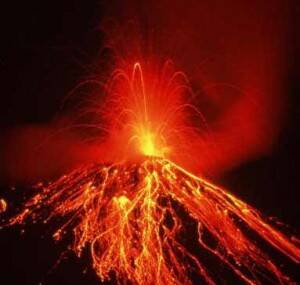Volcanoes formed at certian locations because they were along plate boundaries, which provide the ideal circumstances for magma formation and its subsequent eruption. At subduction boundaries the lithopsheres collide and the denser plate is pulled down into the mantle. This  introduces water into the asthenosphere which lowers melting temperature and allows the less dense magma to rises toward the surface. At divergent boundaries, the plates pull apart creating rifts and decreasing the overall pressure. The decrease in pressure lowers melting temperature and causes large amount of mega to form and then rises to the surface through the rift. Finally over hot spots, plumes of hot solid material that have deep within the earth rise, melt and then lower the pressure. This results in the accumulated of less dense magma which rises to the surface to erupt.
introduces water into the asthenosphere which lowers melting temperature and allows the less dense magma to rises toward the surface. At divergent boundaries, the plates pull apart creating rifts and decreasing the overall pressure. The decrease in pressure lowers melting temperature and causes large amount of mega to form and then rises to the surface through the rift. Finally over hot spots, plumes of hot solid material that have deep within the earth rise, melt and then lower the pressure. This results in the accumulated of less dense magma which rises to the surface to erupt.
Examples of Active Volcanoes
Soufriere Hills, Montserrat– Convergent Boundary: Caribbean & North American Plate
Mount Oyama, Japan– Convergent Boundary: Eurasia & Philippine Plate
White Island, New Zealand– Convergent Boundary: Pacific & Australian Plate
Piton de la Fournaise, Reunion– Not along a crustal plate, hot spot
Krakatou, Indonesia– Convergent Boundary: African & Eurasia Plate
Mount Cameroon, Cameroon– Convergent Boundary: South America & Nazca Plate
Popocatepetl, Mexico– Convergent Boundary: Caribbean & Cocos Plate
Kavachi, Solomon Islands– Convergent Boundary: Pacific & Australian Plate
San Cristobal, Nicaragua– Convergent Boundary: Caribbean & Cocos Plate
Tungurahua, Ecuador– Convergent Boundary: South American & Nazca Plate
Shishaldin, USA– Convergent Boundary: Antarctic & Pacific Plate
Usu, Japan– Convergent Boundary: Eurasian & Pacific Plate
Guagua Pichincha, Ecuador– Convergent Boundary: Pacific & Cocos Plate
Mayon, Philippines– Convergent Boundary: Eurasian & Philippine Plate
Bezymianny, Russia– Convergent Boundary: Antarctic & Pacific Plate
Pacaya, Guatemala– Convergent Boundary: Cocos & Caribbean Plate
Hekla, Iceland– Divergent Boundary: North America & Eurasian Plate
Kilauea, USA– Centre of Pacific Plate, Hot Spot
Karymsky, Russia– Convergent Boundary: Antarctic & Pacific Plate
Convergent Boundary
Soufriere Hills, Montserrat
Mount Oyama, Japan
White Island, New Zealand
Krakatou, Indonesia
Mount Cameroon, Cameroon
Popocatepetl, Mexico
Kavachi, Solomon Islands
San Cristobal, Nicaragua
Tungurahua, Ecuador
Shishaldin, USA
Usu, Japan
Guagua Pichincha, Ecuador
Mayon, Philippines
Bezymianny, Russia
Pacaya, Guatemala
Karymsky, Russia
Divergent Boundary
Hekla, Iceland
Hot Spot
Piton de la Fournaise, Reunion
Kilauea, USA
Most volcanic activity appears to be occurring around the Pacific Plate. From 140E around to 80W, there appears to be a majority of volcanic activity. There are volcanoes clustered between the 80W- 100W as well as the 140E- 160E.
The Pacific Ring of Fire has 452 volcanoes and is home to over 75% of the world’s active and dormant volcanoes. It resembles a horseshoe shape covering almost 40, 000km and is associated a continuous series of oceanic trenches, volcanic arcs, and volcanic belts and/or plate movements.
Example of Volcanoes in Pacific Ring of Fire:
Mount Oyama, Japan
White Island, New Zealand
Krakatou, Indonesia
Popocatepetl, Mexico
Kavachi, Solomon Islands
San Cristobal, Nicaragua
Tungurahua, Ecuador
Shishaldin, USA
Usu, Japan
Guagua Pichincha, Ecuador
Mayon, Philippines
Bezymianny, Russia
Pacaya, Guatemala
Karymsky, Russia
14 of the 20 Volcanoes are located within the Pacific Ring of Fire which is approximately 70% of the total volcanoes. Using the ratio and applying it to all volcanoes on the planet, 75% (452 volcanoes) lie within this area of dense volcanic activity. You can use this ratio to predict that about ¾ of all volcanic eruptions will transpire within this area of the Earth. Based on my analysis, I would expect most future volcanic activity on Earth to take place along plate boundaries (i.e convergent/ divergent boundaries), hot spots, and more specifically within the Pacific Ring of Fire. The plate boundaries provide the optimum circumstances for magma formation and hot spots have plumes of hot material to facilitate magma formation as well. Since a majority of the volcanoes on Earth are located along the convergent and divergent boundaries surrounding the Pacific plate it is an intelligent speculation to hypothesize that a majority of volcanic activity will occur within this region famously dubbed “The Ring of Fire”.
